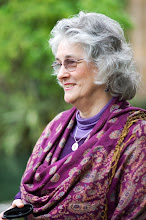 | |||||
| Morning Glory, Morgan, Wynter, Baby Girl |
My old friend Anna Korn and I drove up to the Zell compound
in Cotati after I finished with the Wiccan circle at San Quentin, so we weren’t
there from the very beginning. When we
arrived, there were cars parked up and down both sides of the country road
outside their home and the place was packed.
There was a proverbial groaning board in the dining room that kept
acquiring more and more dishes of food.
Platters of ham, beef, chicken for the carnivores. All manner of salads and side dishes – beans,
pasta, greens, tomatoes and pomegranate seeds, you name it. Plus veggies, breads and many tasty chips for
dipping in many tasty dips. There were
also food tables out on the various decks surrounding the house, with plenty of
folks outside, too. There was a
seemingly endless supply of wines and other potables, including Pyrate Jenny with her lovely basket filled with about a dozen different flasks, each
containing some kind of whiskey or rum.
People congregated in the two living rooms, the den, and in
several seating clusters on the surrounding decks. During this time Zack Darling, using a fancy video camera
with a tripod and a handheld mic, recorded stories about Morning Glory from
individual friends and lovers.
The stated plan was that small groups of people would be
shuttled to the hospital for brief visits with MG. Only two visitors were permitted in her room
at a time.
Anna is an old friend of the Zells and other Pagans at
Greenfield Ranch, and in fact had lived there for a time in her younger years,
so she was going up there to see MG.
However, since I have never been involved with Church of All Worlds, although I’ve attended a
weekend gathering now and then over the past 30+ years, I had planned to defer
visiting to others who were either closer or who’d come from farther away.
My former Holy Terrors coven sister Cerridwen
Fallingstar had visited her only two days earlier, on Thursday, and said
it was a really hard visit because MG was in such intense pain. One of the first friends I spoke with when we
got to the “wake” was Richard
Ely, another old friend. Richard
told me that he too had visited MG a day or so before, and that seeing her in
such extreme pain was difficult. So
hearing this news reinforced my plan to forego a face-to-face visit. It seemed to me that, however much she
appreciated a gathering in her honor, one in which people related loving, often
hilarious tales about her, she had only so much energy in her weakening state. There was only so much time, and there were
so many people!
So I spent the time visiting with old friends, becoming
better acquainted with others, and meeting a few new ones.
When Anna and I arrived, Cerridwen, who planned to drive
back to Marin with us, was off at the hospital with Morning Glory. She told us when she returned that MG seemed
much, much, much better today. Evidently
the medical professionals found the right painkillers for her. I was relieved to learn this.
But it’s the other observation Cerridwen related that upset
me. It turns out that some of the
visitors to Morning Glory’s bedside had never
met her before! Why would someone
who’s never met the patient choose to take up limited time, space, and the
patient’s energy to get some grand introduction? There’s a carrion-esque feel to this
situation. Not that I don’t love carrion
eaters; I am one. But carrion eaters wait till their meal is
dead before diving in.
Now I didn’t ask Morning Glory if she welcomed people who
didn’t know her. Perhaps she did. One might reasonably assume that someone took
on the role of figurative gatekeeper of access to MG, in which case some
boundaries might have been set up.
Again, perhaps someone did and everything was copacetic. I wasn’t there. But I can tell anyone reading this right now:
if I’m in any kind of state wherein my
health is compromised and I need others to care for my daily needs, whether in
a hospital or at home, please do not
bring strangers to my bedside!
 |
| Cerridwen, Avelynn(sp?), Willowoak, Raina, Julie (my hand in foreground) |
Farida, driver for that particular shuttle, soon left for
the hospital with Anna. While they were
gone I mostly hung in the living room where MG’s famous collection of goddess
statues are displayed. Personnel
shifted, but most of the time Julie Epona more or less presided. Others I got to catch up with a little bit
were Anodea Judith,
Willowoak (who was super unsteady on her feet, had fallen more than once that
day, and seemed to want her wine cup refilled often), Raina Woolfolk.
During that period Zack recorded Cerridwen, a former lover
of MG’s, reading a story she’d written about her early days with MG. The scene was a park in a middle class
neighborhood in the Los Angeles area. I
found it to be a magical piece, full of love and sensuality. I was glad I happened to be there to listen
to it told directly to MG via the camera lens.
Anyone who knows Morning Glory knows she’s a sensuous,
sexual, loving being, so it’s not surprising that other lovers spoke, including
MG’s “Filly from Philly,” Diane Nemea Laessig.
Hospital visiting
hours having concluded, we loaded our car to leave when Oberon drove in the
driveway with a car full of folks.
I hope that this
tribute served to lighten the spirits of Morning Glory and all her loved ones
and caregivers.
Photos by Diane Nemea Laessig.



